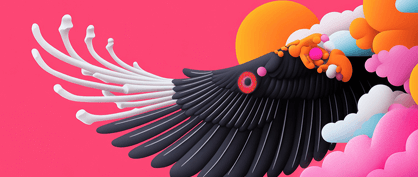Designing Plane Wings Like Bird Wings Could Improve Aircraft Aerodynamics

By Gina Wynn
Bird wing feathers work together to enable the amazing aviators to soar gracefully through the sky, slicing through the air swiftly and lifting the bird like a kite. In the study, “Distributed feather-inspired flow control mitigates stall and expands flight envelope,” Princeton University scientists set out to imitate the qualities of one type of bird feather to see if they could improve aircraft aerodynamics. Their results were published in the Proceedings of the National Academy of Sciences.
Arial Acrobats
Scientists often look to birds as sources of aviation engineering inspiration because of their acrobatic flight capabilities. Their wing feathers, powered by specialized muscles, provide the strength, lift, and control birds need to glide smoothly across the sky then dive seamlessly down to the earth to catch prey.
Rows of short, light, flexible feathers called “covert” feathers—which overlay the longer, stiff wing feathers—help minimize drag and improve lift during flight.
Covert Investigation
The Princeton team experimented to see whether imitating the covert feather design on aircraft would have the same effect on drag and lift as it has on birds. They lined airfoils with rows of lightweight flaps that would deploy passively and observed how they handled in wind tunnels. Airfoils are objects like airplane wings that can be used for airflow testing without involving an entire aircraft.
Although variations of flaps and spoilers are already in use on some aircraft today, they don’t automatically open and close in response to airflow and need to be activated mechanically by a pilot.
Fine-Tuning Flight
The researchers’ tests in the wind tunnel revealed that rows of flaps which deployed passively during high angles of attack (AOA)—when an aircraft tilts up or down during take-off and landing—helped improve lift, reduce drag, and prevent stall. These findings were discussed in the Science News article “Feather-inspired airplane flaps could boost flight performance.”
Flaps placed near the front of the airfoil helped air circulate closer to the structure to produce the effects. Conversely, when the team added a row of flaps to the rear of the airfoil it also helped improve lift—which requires low-pressure air—because it stopped the high-pressure air from flowing forward. Adding five rows of flaps improved the results even more, enhancing lift by 45 percent and reducing drag by 31 percent, Princeton engineer Amy Wissa told Science News.
Wing Wonders
Wissa and her colleagues also tested the performance of passively deploying flaps on the wings of remote-controlled aircraft. Again, they found that the flaps helped prevent stall at high AOA and improved overall flight stability. In addition, the flaps expanded the AOA range by 9 percent, which could aid pilots in maneuvering planes through heavy wind gusts and landings on short runways.
These exciting discoveries in aerodynamics, inspired by our feathered friends, could take flight to new heights. In the future, they could help engineers design airplanes that are more efficient, easier to control, and safer.
Discussion Questions
- Name some other inventions that were inspired by animal biology.
- What other objects are affected by aerodynamics?
- Give examples of how people can be affected by aerodynamics.